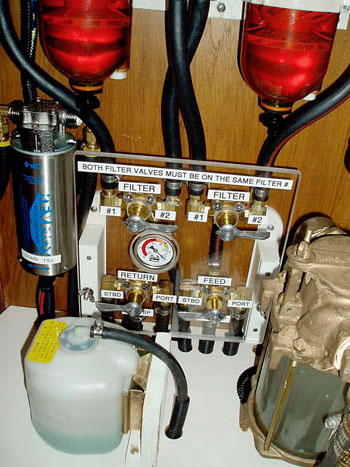Backup Fuel System
Supplied by Bill Martinelli, Voyager #11
Catalina used a fuel filtering system that I don’t care for – that each tank has its own Racor filter. I prefer redundant filters – multiple filters that are used on all tanks. Here is how it works; all supply and return lines go to either 3-way or 4-way valves. If you have two fuel tanks you use four 3-way valves and if you have three tanks you use two 3-way valves and two 4-way valves. My C470 has three tanks and two Racor filters and that is what I will use as an example.
All three tanks feed to the three inlet ports of a 4-way valve, the outlet port feeds to an additional 3-way valve. This 3-way valve has two outlet ports, each of these go to the inlet ports of my two Racor filters. The two outlets from the filters go to the inlet ports of a second 3-way valve. The outlet port goes to the supply line of the engine. In this supply line there is a tee fitting, in which is mounted a Racor vacuum gauge to monitor the condition of the filters. The return line from the engine goes to the inlet port of a second 4-way valve and the three outlet ports go to back to the tanks.
This is the way it works: on the feed and return 4-way valves you choose the tank you wish to feed from and return to, same as the standard Catalina installation. On my boat this is from port or starboard aft tanks or from the mid port tank, and just as you can with the stock setup you can feed from one and return to a different one. The main difference is the two other 3-way valves. They let you choose which filter you wish to use, in my case I have labeled them #1 and #2. When you start off with clean filters you start with #1.
When making a long or rough passage I can check the vacuum gauge to see if a filter is staring to block up. Generally the gauge will show almost if not zero vacuum, if it is reading a high amount of vacuum all I have to do is turn both 3-way valves to filter #2 and the gauge will drop to zero. You don’t have to stop the engine and it will never miss a beat. Now we can keep motoring along and if I am really concerned I can open up #1 and slap a new filter element into it. Later if you want to switch back to #1 do it with the engine running at cruising speed and any air will bypass the injectors and go to the return lines and into the tank, again without the engine missing a beat.
I have rigged this system on a number of boats both sail and power over the years and it works every time. When you first run the engine after changing filters, the vacuum will show higher amounts of vacuum because of the air trapped in the lines or filters. As the air dissipates, the vacuum will read lower and lower until almost zero, again running without missing a beat. Without the gauge you wouldn’t even know the air was there.
One of the last things I want to need to do is change filters in the middle of a rough passage and smell diesel fuel for hours afterwards. That is probably one of the best ways to make your crew toss their cookies.
Below is the revamped fuel panel and the fuel routing.

